Sukhjit Singh's Blog, page 6
December 23, 2020
MSP – Minimum Support Price or Maximum Sales Price? What profit does farmer makes?
Government defines Minimum Support Price, MSP, as a tool which gives guarantee to the farmers, prior to the sowing season, that a fair amount of price is fixed to their upcoming crop to encourage higher investment and production of agricultural commodities. The MSP is in the nature of an assured market at a minimum guaranteed price offered by the Government.
MSP is declared by central government for 23 crops on the advice of the Commission for Agricultural Costs and Prices (CACP). CACP calculates three different costs of production for each crop in the list.
1. A2 (actual paid out cost) = spend on seeds, fertilisers, pesticides, and hired labour and machinery
2. A2+FL = A2 + the economic value of the efforts of family members working on the farm
3. C2 (comprehensive cost) = A2+FL+ imputed rent and interest on owned land, other assets and capital
Swaminathan report recommends that MSP should be at least 50% higher than total cost, C2. During the election campaign for the 2014 Lok Sabha elections, Narendra Modi had campaigned that his government would implement the recommendations made by the Swaminathan commission on farmers. Even though the PM and his party continues to claim that they have implemented 50% profits for the farmers, the truth was revealed in response to an RTI by PP Kapoor in April of 2016. Agriculture Ministry in response to his RTI said – “The recommendation of the Swaminathan commission regarding the minimum support price (MSP) was rejected by the government because the MSP is decided by the Commission for Agricultural Costs and Prices after taking into consideration all the varieties. Therefore, deciding a minimum 50% hike over the cost could lead to distortions in the market.”
Currently, the MSP is calculated using A2 + FL. Even though UPA government also announced MSP at 50% profit over A2+FL, the PR of current regime is unmatched and hence the world is told that Modi is the PM to provide farmers with 50% profits over their costs.
As per a study by thewire.in in February 2020, considering MSPs for Kharif crops announced in 2019-20 – “if all crops falling in the purview of MSP are included, the margin of total profit is only 14% over cost C2.”
Still, if MSP is indeed the minimum price a farmer gets for his/her produce we are sure that farmer gets atleast 14% profits. That would still be something to take home. However, this 14% number will be true if we assume-
1. The calculations of costs involved which form the basis of the MSP (A2+FL and C2) are accurate and reflect ground reality; and
2. Every farmer is able to sell his/her produce at least at MSP.
Let us look at question 2 first.
Shanta Kumar report (2015) indicates that at present only 6% of farmers in India have access to MSP and that too for about 35% of their produce. So, in a way only 2% produce gets MSP. “If one adds all agricultural households having sold paddy and wheat to any procurement agency, during July2012-June2013, the number of households comes to just 5.21. This figure of 5.21 million households as a percentage of total number of agricultural households (90.2 million) comes to just 5.8 percent. But if one adjusts this with common households that sell both paddy and wheat, and/or by the percent of quantity sold by each household at MSP, the figure of direct beneficiaries comes even lower. For staples other than wheat and paddy, the situation is far worse.”
A report published by factly.in in Feb 2019 shows the relation between declared MSP and average selling price of the crop for month of Oct 2018.
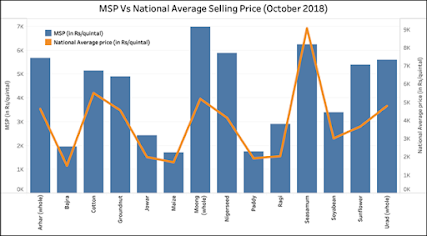
Note – that barring one exception, the national average selling price is significantly lower than MSP. In many cases the selling price is lower than C2. So even if our answer to question 1 is yes, that we can 100% rely on production cost numbers A2+FL and C2, the farmers don’t have access to selling prices which are in excess of MSP and only 6% farmers have access to MSP for about 30-35% produce. This means that profits for farmers are much less than 14% (against C2), many a times they make losses.
Let us look at question 1. How reliable are C2 & A2+FL numbers?
As per a report by thewire.in (February 2020), where they accessed communications from various state governments to the central government in regard to MSP for Kharif crops for 2019-20, atleast nine states, including BJP ruled states, have disagreed with CACP advised costs. Some of the observations of state governments are -
Haryana (BJP Khattar Government) – After examining the CACP report, the state agriculture department said in its letter, sent on May 18, 2019, “It is pertinent to mention that the price of diesel, pesticide, fertiliser, machines and other inputs has increased this year as compared to the previous year. Lower availability of labour is also a major contributor in increasing the cost of cultivation.”
For Bajra they said - “Department of Agriculture and Farmers Welfare has estimated the input cost for the crop as Rs 2,170, but the CACP has recommended Rs 2,000 per quintal as the MSP.”
“The state government is making strong efforts for diversification of Paddy to Maize crop, therefore, we need strong support for increasing the MSP of this crop for adoption by the farmers…. CACP has recommended Rs 1,760 per quintal which is very less and does not even cover the cost of cultivation. The MSP of Maize should be fixed at Rs 2,350 per quintal.”
Uttar Pradesh (BJP Yogi Government) – The state assessed the Cultivation Cost (C2) of paddy to be Rs 1,679 per quintal and recommended the MSP to be Rs 2,520 per quintal. However, the Centre fixed the MSP at Rs 1,815 per quintal.
Karnatka - “The MSP fixed for the 2019-20 season is inadequate compared to the state’s cultivation cost. Because of this, the profit margin of the farmers is either little or negative.”
So, we can’t even trust the production cost numbers which are being used to calculate MSP numbers.
Which essentially means the farmers lose out on all sides of the equation. Neither are the costs as per Swaminathan recommendations (C2), nor are the calculated costs as per ground reality, and nor are the selling prices at or higher than MSP.
If you run a business, you know how a profit and loss analysis is done. Any big corporation before bidding for any work spend days planning to come with best possible profits to win the work. They consider all sorts of costs - Compensation to workers (starting from the top management, to the assistants and clerks to print and office boys who serve coffee), Rent of offices and factories they use, Depreciation of their assets, Cost of raw materials, Design and engineering costs, costs of testing and validations, costs for travel of team members, costs of entertainment (team and clients), logistics costs (Transportation, handling of equipment), Cost of internet, Phones, Car fuel, Taxi bills, legal fees, Insurance, electricity bill, customs, octroi and all possible other costs – before they come to a price on which they will sell their products ad services so that they can make reasonable profits.
How do governments and public institutes prepare their financial statements? – with as much detail as corporates.
So, why is it that when a farmer’s profitability has to be calculated, suddenly all the costs to be considered seem like a burden?
The truth is - agriculture in general is a loss-making proposition.
Swaminathan reports in an urgent wake up call (this was 2005-2006) state “The acute agricultural distress now witnessed in the country, occasionally taking the form of suicides by farmers, is the symptom of a deep seated malady arising from inadequate public investment and insufficient public action in recent years. The precise causes of the agrarian crisis are many and varied, but there are five basic factors which are central to the present crises. These are: unfinished agenda in land reform, quantity and quality of water, technology fatigue, access, adequacy and timeliness of institutional credit, and opportunities for assured and remunerative marketing.”
The farmers are fighting for the last - assured and remunerative marketing.
#KisanEktaMorcha
#StandWithFarmers
#SpeakUpForFarmers
(first published on 08 Dec 20 @ MSP – Minimum Support Price or Maximum Sales Price? What profit does farmer makes? (punjabtodaytv.com)
December 22, 2020
FARMERS, CROWS & BLACK KITES
Through the maze of electrical wires, through the cloud of crows and black kites (cheel), through a very thin layer of smoke that the city makes on its roads, one sees a beautiful sunset. The sun is setting behind a small hill. The hill, if one gets closer, is decades of unsegregated waste produced by dilwalon-ki-dilli. A problem away from their eyes, a problem away from their noses, a problem away from their homes and colonies. Akhon pare, te jag mare, or as they say it a little politely in English – out of sight out of mind.
The farmers have been out of their sight for decades. Occasionally they have seen them on TV dumping their produce on the highways, sometimes they have heard of their suicides, but then they have plenty of their own to worry, plus the primetimes are so informative – they get to know about important suicides there, sometimes for months on one particular most important suicide.
But every now and then there is a storm, a strong wind blows, the stench from the landfill reaches far inside the city, the city that has expanded anyways to encircle the landfill which was once far enough. Every once in a while, the crows and black kites wander farther into the city skies and drop unwanted items onto the city’s roofs and gardens. Every now and then there is a fire at the landfill and smoke rises like a cloud and engulfs the city’s limited imagination. Every now and then, what was out of sight, becomes visible.
On 25th November one such fire broke out. First at the landfill. And then in the countryside. The fire at the landfill engulfed Delhi momentarily before the fire tenders got it under control. But the fire that broke in the countryside created a storm that is still enraging. Farmer – long out of sight, sits at their doorsteps. Like the crows and black kites, like the height of the landfill – an eyesore to Dilwalon-ki-Dilli and Delhi throne.
Google map shows a rather easy route to the protest site. Straight to sector 62, get on the expressway and in 6 km at the Ghazipur border. But google doesn’t account for UP police’s arrangements. All entrances to the Meerut-Delhi side of the expressway are sealed and even the road itself is barricaded at multiple places. As I take the service lane and turn into a narrow lane leading in the general direction of Ghazipur I see a group of 50 odd BKU flag holding youngsters having a confrontation with the police at that barricade. They make it to the protest site much faster than I will. There is strength in numbers.
The largest meat mandi (fish/murga/bakra) in the region and a qutub minar high hill of waste offer enough opportunities for the sky to be full of crows and black kites. These birds, surviving on refuse of the city and the refuse of the meat mandi, have something new to behold from the exclusive view in the skies. A mini township of tents and trolleys.
I sit on the edge of the expressway and listen as speaker after speaker address the gathering (sitting on mats on the expressway). Rakesh Tikait of BKU (Tikait) addresses the gathering. Brijendar (who apparently is from another union) doesn’t allow me to listen to any word Tikait has to say. He has lots to say himself, but with the background sound from speakers I barely understand one of every five words he has to say. What I understand is that he doesn’t like Tikait. He thinks he will sell out – that he is just waiting for the right offer.
A little while later I understand his grudge. Behind the stage where Tikait addressed the crowd, there is another stage. Set up by two unions. Till a few days back they were sharing the same stage till Tikait spoke against the leaders of these two unions, especially against VM Singh of Rashtriya Kisan Majdoor Sanghathan. Although both the stages speak of the same demands – repeal of the three farm laws, for the time being they speak from different stages. A little while later I find another small stage of another union, with the same demands.
The mood at Ghazipur, like at Singhu is festive. There are many langars, a medical camp, a bookstall, a group of young nihangs doing gatka, media, and plenty of police and security personal walking among the crowd, partaking the langar (and hopefully keeping watch). There are youngsters and there are elderly, though not many females. A city lady has her camera out and is walking through the crowd, clicking faces of the elderly from up close – as close as few inches sometimes, of farmers talking, of farmers eating, of farmers sitting – she is spoilt for choices – there are so many faces (what was always out of sight, is so close to it momentarily). Little children from nearby shanties are having their fill from langar. Many poor are standing on the edges with their collection of plastic waste – they seem to have abandoned the landfill for the day to collect the disposable plastics here.
Overhead the crows and black kites dot the sky. They have not ventured to sit on the expressway before. But with the speeding vehicles paused for the moment some of them alight on the sides and on the road. The gathered farmers pose no threat to them. The crows and black kites pose no threat to the gathered farmers.
There are some crows and black kites, who do pose a threat to the gathered farmers. As the sun sets behind the hill of waste, those crows and black kites sit in their gilded halls, in the heart of the city, scheming and planning.
#KisanEktaMorcha
#StandWithFarmers
#SpeakUpForFarmers
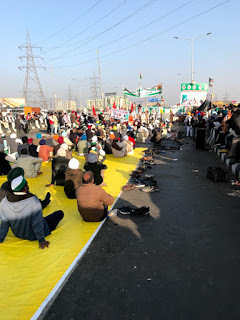

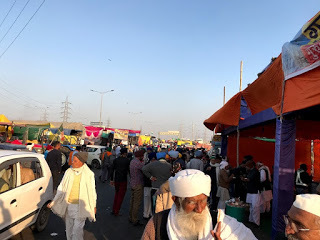
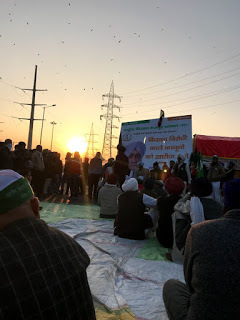
FARMERS MOVEMENT – A WHEEL OF DHARMA
Noida Gate or Gateway to Noida on the Noida Delhi carriageway at Chilla border, the metallic gate made of multiple inverted arches in blue and white, welcomes people to Noida, in the presence of Gautam Buddha. The white marble statue of Buddha sitting in padamasna with his hands in ‘Dharmachakra mudra’ is placed in the middle of the road, next to the gate.
This is also the site of the protest by farmers. They have been here since the beginning of December. One side traffic leading to Delhi has been blocked. When the chief of Bhartiya Kisan Union, BKU (Bhanu) met Rajnath Singh and declared that they will open the traffic his union saw open rebellion and nearly 400 members resigned. His son Yogesh refused to comply to his orders and went on an indefinite hunger strike. When I drove to the location the traffic on this side was open, the number of protestors having reduced significantly after the split in the union. Police outnumbered the protestors by 2 to 1.
Rajwinder Singh, a farmer from close to Lukhnow, said that they have more farmers on the way and they will block the road again the next day. By next evening they had sufficient numbers to do that. The morning after that I visited again. The police barricading started nearly ten kilometers away on the expressway. Any vehicle which looked like carrying farmers was being stopped and checked. Traffic was diverted about a kilometer ahead of the Chilla border. Few police officers were considerate and let me go through at the mention of ‘langar.’
Yogesh, the UP unit chief of BKU Bhanu, in his fifth day of hunger strike looks cheerful as he stands amidst a group of fellow farmers. He greets me with a big smile. His health is fine for now (doctors have been checking on him regularly, ready to do their duty in case situation demands). He is positive that the farmer demands are genuine and that they will not leave till these laws are repealed. On why the number of farmers is so low here he says that UP administration has made it very difficult for farmers to reach here. Their tractor trolleys are being confiscated. All their village and block level leaders are literally under house arrests. One of the local leaders who reached says that the local police officer at his block has been suspended after he managed to evade their surveillance and reach the protests.
There is another union camping nearby at Dalit Prerna Sthal. For now, this group is holding onto one side of the road with whatever limited numbers they have. Unlike other protest sites there are no stages or speeches here. There are no big langars here either, they have a makeshift chulha on pedestrian walkway acting as their kitchen.
I check with the local gurudwara. They say that they supported the protestors initially, but since their leader joined the govt side even the gurudwara team felt a bit betrayed and stopped sending help. Now that these guys are showing some conviction again the team feels they will start their help again. Even the gurudwara management has been advised (unofficially of course) to not support the protestors but they do it without making it too obvious.
“Dharmachakra in Sanskrit means the 'Wheel of Dharma'. This mudra symbolizes one of the most important moments in the life of Buddha, the occasion when he preached to his companions the first sermon after his Enlightenment. It thus denotes the setting into motion of the Wheel of the teaching of the Dharma.”
As this paltry group of farmers, a part of a larger farmers movement, sit facing the Buddha and his Dharmachakra, they have set in motion their very own wheel of Dharma.
#KisanEktaMorcha
#StandWithFarmers
#SpeakUpForFarmers
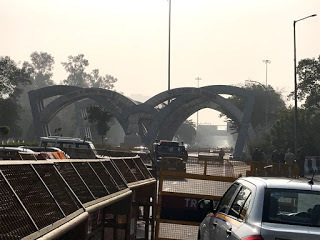
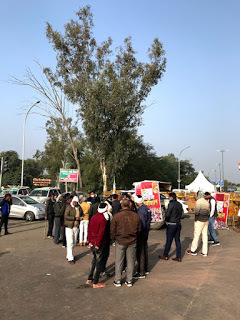
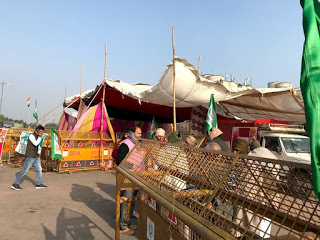
December 21, 2020
MANTO AT SINGHU
It is a small poster, with a longish quote typed in a rather small font, carrying a face not too familiar to the thousands walking by. Thus, suspended on a bamboo, in front of a tractor, in the midst of this fair of solidarity, this celebration of resistance, one encounters Manto.
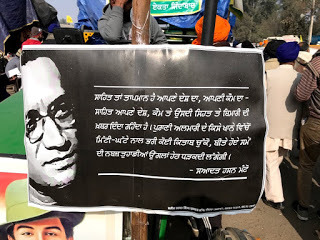
Here he in the company of Bhagat Singh and of Banda Singh Bahadur. Probably, unfamiliar territory for him, but not for his writings. His words, undivided by partition, speak for him.
‘Sahit taan tapman hai apne desh da, apni kaum da – Sahit apne desh, kaum te usdi sehat ate bimari di khabar dinda rehanda hai. Purani almari de kise khane vichon mitti-ghate naal bhari koi kitab chukko, beete hoye samein di nabaz tuhadiyan ungla heth dhadakdi lagegi.’
‘Literature is the pulse of one’s country, one’s community – Literature tells the news of health and illness of one’s country and community. From the shelves of an old almirah pick a dust laden book, you will feel the pulse of the past beat under your fingers.’
In his dedication ਇਹ ਮੇਲਾ ਹੈ ‘Eh mela hai’ ‘This is a carnival’ to the farmers movement, to those currently camping at Delhi Borders, Surjit Patar answers the state’s misleading question on who is participating in these protests.
ਇਹਦੇ ਵਿਚ ਧਰਤ ਸ਼ਾਮਲ, ਬਿਰਖ, ਪਾਣੀ, ਪੌਣ ਸ਼ਾਮਲ ਨੇ
Soil is here, Trees, water, air are here,
ਇਹਦੇ ਵਿਚ ਸਾਡੇ ਹਾਸੇ, ਹੰਝੂ, ਸਾਡੇ ਗੌਣ ਸ਼ਾਮਲ ਨੇ
Our laughter, our tears, our songs are here,
ਤੇ ਤੈਨੂੰ ਕੁਝ ਪਤਾ ਹੀ ਨਈਂ ਇਹਦੇ ਵਿਚ ਕੌਣ ਸ਼ਾਮਲ ਨੇ
And you don’t know, who is here?
ਇਹਦੇ ਵਿਚ ਪੁਰਖਿਆਂ ਦਾ ਰਾਂਗਲਾ ਇਤਿਹਾਸ ਸ਼ਾਮਲ ਹੈ
Our forefather’s celebrated history is here,
ਇਹਦੇ ਵਿਚ ਸਿਦਕ ਸਾਡਾ, ਸਬਰ, ਸਾਡੀ ਆਸ ਸ਼ਾਮਲ ਹੈ
Our faith, patience, our hope is here,
ਇਹਦੇ ਵਿਚ ਸ਼ਬਦ, ਸੁਰਤੀ, ਧੁਨ ਅਤੇ ਅਰਦਾਸ ਸ਼ਾਮਲ ਹੈ
Our words, awareness, passion and prayer are here
ਤੇ ਤੈਨੂੰ ਕੁਝ ਪਤਾ ਹੀ ਨਈਂ
And you don’t know?
ਇਹਦੇ ਵਿਚ ਵਰਤਮਾਨ, ਅਤੀਤ ਨਾਲ ਭਵਿੱਖ ਸ਼ਾਮਲ ਹੈ
Present is here, past and future are here,
ਇਹਦੇ ਵਿਚ ਹਿੰਦੂ ਮੁਸਲਮ, ਬੁੱਧ, ਜੈਨ ਤੇ ਸਿੱਖ ਸ਼ਾਮਲ ਹੈ
Hindu, Muslim, Budh, Jain and Sikh are here
ਬੜਾ ਕੁਝ ਦਿਸ ਰਿਹਾ ਤੇ ਕਿੰਨਾ ਹੋਰ ਅਦਿੱਖ ਸ਼ਾਮਿਲ ਹੈ
Many things one sees, and much unseen is here
ਇਹ ਮੇਲਾ ਹੈ
This is a carnival.
Manto will be pleased that Patar sahab has recorded the pulse of today.
Manto will be pleased to know that over two hundred poems dedicated to the farmers movement have been written and are published as ‘dharat vangare takhat nu’ ‘soil challenges the crown’.
Manto will be pleased to know that from celebrated writers and singers to young ten year olds, all are penning stories and songs for the movement.
Manto will be pleased to glance at the first edition of TrolleyTimes.
And much more than that Manto will be pleased to take a walk through the tractor-trolley townships and see elderly and young holding books, learning from their glorious past, from those whose posters surround the one Manto finds himself on. Every few hundred meters there is a collection of books, some better organized, some just sitting in tokras (large baskets).
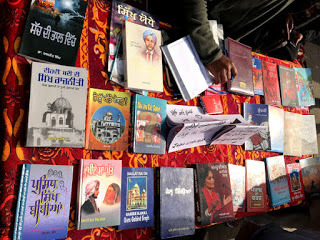
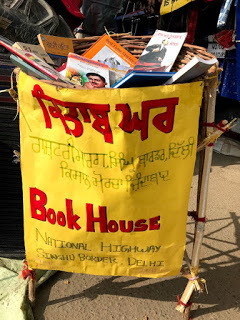
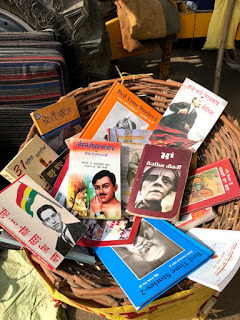
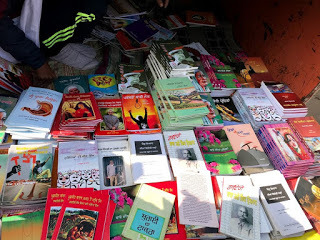
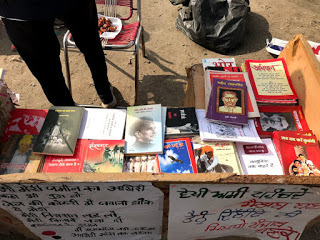
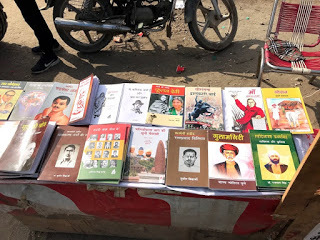
December 20, 2020
HOMAGE DAY
“All India Kisan Sabha (AIKS) Saturday claimed that 33 farmers participating in the ongoing protests have so far died since November 26 due to accidents, illness and cold weather conditions.
According to AIKS, ‘Homage Day’ will be observed in different parts of the country on Sunday to pay tributes to those farmers who lost their lives.” – The Tribune, 19 December 2020.
Walk with them, through the sea of tractor-trolleys, through the sea of humanity, through the sea of slogans.
Walk with them in homage.
The poster in Punjabi says – ‘Inquilab udeekeyan nahi, keeteyan aunda hai‘ - ‘Revolution doesn’t happen by waiting, it happens by doing.’
Sir Choturam’s quote in Hindi – ‘Doosre log jab sarkar se naraaz hote hain, to kanoon todte hain. Par kisaan jab naraaz hoga to kanoon nahi todega, sarkar ki peeth bhi todega’ ‘Other people when upset with government break laws. But when farmers will be upset with government, they will not break laws, they will also break the government’s back.’
PS – Do the elderly look like they are in any hurry? There is a reason they have put Sir Choturam’s quote!
PS - There is a reason why inquilab is written in red.
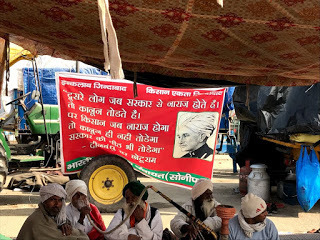
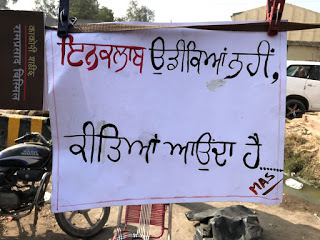
FARMERS MOVEMENT – CONTROLLING THE NARRATIVE
Walking through the tractor-trolley township of the farmers movement gives one hope. No matter how deep you walk along the many miles of the township, the spirit, the josh never leaves. Amidst the speeches, the sloganeering, the cooking and consuming of langars, the cleaning of living and walking spaces, the men and women have made this place their homes. Groups sit playing cards and smoking hukkas like they are sitting at their village corners. And everyone here is looking after their corners and looking after one another.
Amidst fighting this battle at many fronts - on marches against the police and state machinery, on roads here with the elements of the North Indian winters, of managing the logistics of living on roads and keeping the josh alive, in meetings with govt – the farmers movement is also giving a lesson or two to others on two key fronts – fighting misinformation and controlling narrative - which essentially boils down to handling the lapdog mainstream media and the Joseph Goebbels of our times ‘the BJP IT Cell.’
And may be the future generations of this country will be thankful to this movement for ensuring that these vultures were dealt with properly.
These images from Singhu tell a tale of how far the mainstream media have fallen in the eyes of the common man.
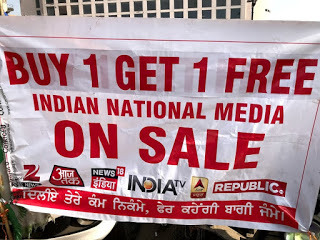
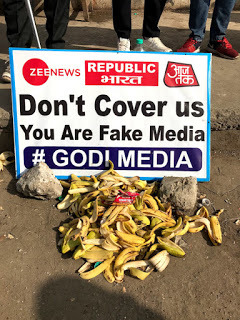
We have seen videos where youngsters are escorting the reporters from these lapdog organisations out of the protest sites. Independent media, youtube channels, small media houses are welcomed by farmers with open arms and given full access with warmth and hospitality. And even with these smaller organisations the position of movement leaders is that if you want an official statement of the sanyukt morcha – attend the press conference (the only place for official statements).
What the BJP IT cell didn’t account for was that not only the sons and daughters of these farmers, many farmers themselves know how to handle smart phones and be present on social media. And boy-oh-boy did they forget about the diaspora and the farming community’s reach all over the world. #Tractor2Twitter trended with vigor.
And the movement has given a lesson or two to the mouthpiece celebrities as well. Photos of Kangna with a blackened face are pasted everywhere. She is used to getting a free pass from most other celebrities in Bollywood for fear of troll onslaught, but celebrities from Panjab answered her punch to punch.
Someone has put a message for her on a poster pasted on a drum. The photo and message explain how after having spent their days in Mir Manu’s prison grinding fifty kg wheat every day, surviving on one bread and water and having heads of little children garlanded around their necks, the women prayed to the almighty for the welfare of all - even their oppressors. The message tells Kangna that the women in this movement are the daughters of these women.

As the movement completes three weeks, more and more citizens (of our country and of the world) are joining it. Hundreds of independent voices join everyday to help, support and build the narrative and spread correct information.
A group of volunteers have started TrolleyTimes – a biweekly in Punjabi and Hindi covering news, statements, stories, images and poetry related to the movement.
And in an organized effort to counter the BJP IT cell, the volunteers have now launched an all out social media force under the banner KisanEktaMorcha. Search for it on Facebook, Youtube, Twitter, Instagram and other platforms and join the movement.
Remember – this is not only for the farmers, this one is for the ages. Come join the movement.
सिर्फहंगामा खड़ा करना मेरामकसद नहीं,
सारीकोशिश है कि येसूरत बदलनी चाहिए।
मेरेसीने में नहीं तोतेरे सीने में सही,
हो कहीं भी आग, लेकिन आग जलनी चाहिए।
PS - Please follow, subscribe, like KisanEktaMorcha pages on all social media platforms. Do double check the official pages before subscribing. Many unofficial pages are using the logo and similar names.
Subscribe to youtube channel - https://www.youtube.com/channel/UC4mG...
Follow and like the facebook page - https://www.facebook.com/kisanektamorcha
Follow on Instagram - https://www.instagram.com/kisanektamo...
Follow on twitter - https://twitter.com/Kisanektamorcha
December 19, 2020
A MEMORIAL AT SINGHU BORDER
Today, 19 December 2020, Sikhs all over the world commemorate the sacrifice of the ninth Guru, Guru Teg Bahadur Saheb. Hind-di-chadar Shri Guru Teg Bahadur sacrificed himself standing with and for the weak, standing against a tyrant.
As is the fashion these days, politicians appropriating historical and religious figures, in January 2020 Congress government in Punjab announced a year long celebration of Guru’s 400th birth anniversary (April 2020 to April 2021). Not to be left behind, Akali dal (then a part of NDA govt at center) got the Govt of India to announce a nationwide celebration of 400th birth anniversary – with the President making the proclamation in his address to a joint sitting of the Parliament. In November 2020, Delhi team of Akali Dal (who was by then out of NDA govt) started six-month long celebrations. As we approach April 2021, every politician will line up with big words proclaiming Guru’s legacy – with a turban wearing Modi leading the pack.
According to Delhi tourism website – “With a view to beautify all the entry points of Delhi, Government of NCT of Delhi has set up Guru Tegh Bahadur Memorial near Singhu Boarder (G.T.Karnal Road) National Highway-1.”
The police barricades which indicate the start of the tractor trolley township of the farmer movement, are placed where the memorial starts. As one walks to join the lacs gathered, one first crosses the Guru’s memorial. If one steps inside a tall khanda rising from the ground comes in view. “A 24 meter high central pylon with petals at the base represents the Guru & his strength and the three “C” arches denote his three followers and the monoliths represent the 10 Sikh Gurus’ with their sayings inscribed on them.” The words of Gurbani on these ten pillars give messages like Sarbhat da bhala (welfare of all), kirat karna (hard work and honest living), naam japna (remembering God), vand chakna (sharing with others), istri samanta (equality of women), etc.
As part of six-month celebrations Delhi Akali Dal team has planned a nagar kirtan (a procession of devotees) from birthplace of Guru (Amritsar) to place of his death (Delhi) in February 2021.
Sons and daughters of Guru in their lacs have marched upon Delhi much ahead of the schedule. The 400th year celebration hadn’t anticipated such gathering in celebration of the spirit of Guru. Standing up to a tyrant. Standing with the weak. Other communities have joined these sons and daughters of the Guru in the people’s movement they started.
One of the ten pillars inside the memorial say tenth Guru’s words under the heading ‘Deedar Khalse ka’ – ‘Behold the pure.” ‘Khalsa mero roop hai khas, Khalse mehi ho karo nivas’ ‘Khalsa is my true form Within the Khalsa, I abide.’
May those who speak on stages appropriating the Guru’s legacy – take a moment to understand the significance of the gathering next to Guru Teg Bahadur Memorial at Singhu border. May they go and bow to the Guru awaiting at their doorsteps. May they go and bow to the real memorial to the Guru gathered at their doorsteps.
And may the people of the land continue to remember what the Guru stood and sacrificed for.
#StandWithFarmers
#SpeakUpForFarmers
#KisanEktaMorcha
December 18, 2020
MAJHA. MALWA. DOABA.
Punjab – land of five rivers, first partitioned and then trifurcated, at present is a land of practically two rivers. Not delving too much on the historical usage of the terms – currently this side of Sutlej is called Malwa, that side of Beas is Majha and in between the two is Doaba.
My father is Malwayi. My mother is Majhail. Doaba is their home for nearly five decades - we siblings are thus Doabiye.
End October, as Punjab is busy protesting on roads and railway tracks, and harvesting paddy, I ask ma – ‘Majhewale patryian te baithe, malwe wale toll pumpa te. Eh doabiye kuch karange?’ ‘Those in Majha are sitting on tracks, those in Malwa are sitting at tolls, Reliance filling stations. Will the doabiyas do anything?’
‘Ehna nu te bas kam te paise di ag lagi. ’ ‘They are running after more - more work, more money.’ ‘eh ni nikalde cheti.’ They won’t come out easily.
Of the three regions – Doaba was the first to change (some say develop) with incoming NRI money. Of the three regions – Doabiye are the closest to the urban middle class. They don’t get out of their comfort zone easily.
Walking through the township of tractor-trolleys at Singhu border I notice names from the Doaba region – Kapurthala, Jalandhar, even a banner of a union for farmers from Doaba. I walk to a group of youngsters standing next to one such trolley - full of posters highlighting Godi Media. They are from a village close to Jalandhar.
‘Doabiye bada time laake nikle?’ ‘Doabiye took a lot of time to come out,’ I ask them after a few minutes of conversation.
‘Haanji bhaji. Doabiye nikalan nu time launde. But ek vaar nikal pain, fer sab nu pichche chad dinde. Fer ni mud de.’ ‘Yes brother. Doabiye take time to get started. But once they come, they stand at the front. They don’t turn back then.’
When I called home this morning, there was an announcement on the village gurudwara speakers in the background. I asked Ma what they were saying.
‘Reliance da boycott karan di announcement hai. Sab apne jio number band karwayo.’ ‘Its an announcement to boycott Reliance. Everyone has to stop using Jio numbers.’
Doaba took its time. But it is in the middle of the battle now – with full vigor. It is in the middle of the movement now – with full participation.
Majha Malwa Doaba stand together.
Communities at loggerheads for decades - Trifurcated Punjab - stand together.
Groups at conflict with each other for decades– Trader Farmer Laborer - stand together.
There is hope now – for a country currently on a fast-track to hate and division – there is hope that India might still stand together.#StandWithFarmers#SpeakUpForFarmers
December 15, 2020
FUTURE IS NOW
Browsing through facebook messages, I noticed a college friend’s post and a few comments from the same college janta having their fun discussing pizza langar at the farm protests and availability of leg massages and speculating on the possibility of whisky as well!
And it struck me that over last two weeks I had not seen much feed from a few hundred IITians in my friends list. A very large number of these were very active prior to 2014 (and have made their appearances every once in a while to celebrate/support something related to their 2014 achievement – surgical strike on money – DeMo, surgical strike on Pak, surgical strike on corona – Lockdown, etc. etc. ). IITians for change, IITians for India, IITians support MODI and many other groups with names like these sprung up in the run up to 2014 and then 2019 (and will probably come up prior to 2024 again) – though I don’t have much hope of a group being called ‘IITians for change’ again.
Maybe I have just missed their discussions. So, I undertook a quick survey – at random I opened nearly fifty profiles from my friend list, of janta from my college. Mostly - there is no post in last few weeks, even on the walls of highly regular social media users.
In relation with farmer protests - apart from the pizza discussion, I found one forwarding videos against the movement from an extreme right wing hate page, one who had posted one link in support with #IStandWithFarmers and one with two supposedly funny videos bashing Modi on farm laws.
For almost 50 IITians, out of which nearly half have been very active users of facebook and a high percentage of those highly active in support of current establishment’s policies – mostly there is no voice either in favor or against the current events.
Maybe they have moved away from regular use of facebook and stopped trying to change the world on social media, but something that I posted a few weeks back comes to mind. “Till 2014, we had many an expert critic, many an expert doctor, who smelt the stink that Mother India lived through. Every moment of their existence they diagnosed what was wrong with her and they prescribed and shouted the solutions every which way. Since 2014 many well-meaning noses have lost the ability.”
4th December 2020, 930pm. As thousands of farmers at various borders of Delhi got ready to layout their bedding in their temporary shelters (in trolleys, on road under trolleys, in tents, out under open skies) in biting cold, Prime Minister delivered keynote address at the IIT-2020 Global Summit.
Maybe his words (or whoever wrote the speech) can help.
“I am always impressed after interacting with students from IITs. I also come back refreshed and reassured about the future of India and our planet. Friends, you are sons and daughters of India. You are serving humanity.”
“Friends our actions today will shape our planet tomorrow.”
“The responsibility is heavy, but I know your shoulders are capable.”
The choice of theme by PanIIT team seems prophetic - Future is Now.
December 14, 2020
ADVERSITY TO OPPORTUNITY
Farmers had been sitting on roads, railway stations and tracks for nearly two months.
Modi govt had by and large ignored them – like they have every other dissenting voice (if not outright crush it).
Farmers needed fertilizers for rabi sowing.
Modi govt saw an opportunity to force the farmers to leave railway tracks and stations, and hence leave their protest.
Farmers moved away from tracks and stations and said you can run goods trains.
Modi govt said no goods trains if no passenger trains. When you have the opponent by their throat why relent?
Farmers took another step back. The trains started.
What can people do against an inconsiderate ruler?
Some convert that adversity into opportunity.
TRAINS JAM-PACKED AS PUNJAB FARMERS LEAVE FOR DELHI - THE TRIBUNE 14-DEC-20
Alluding towards the heavy presence of farmers heading to take part in the agitation, an elated Gursewak Singh (60) said, “The Dainik Express from Bathinda to Delhi has turned into ‘Kisan Express’ now. Resumption of train services has indeed served as an easy mode of transportation for thousands of farmers travelling to and from Delhi borders.”
#StandWithFarmers
#SpeakUpForFarmers



